When the question “Why do brides wear white” is asked, the most frequent answer is “Because Queen Victoria did”, or “to show that they are virgins.”
The first answer is more or less accurate, but glosses over centuries of white wedding dresses worn before Queen Victoria’s wedding, and decades of coloured wedding dresses after her wedding, and also doesn’t explain why Victoria wore a white wedding dress. The 2nd answer is mostly rubbish and dates to the mid-20th century.
Long before Victoria, white was a popular choice for wedding dresses, at least among the wealthy nobility.
Weddings were usually more about political alliances and transfers of wealth than they were about romance, and so the wedding dress was just another excuse to show the wealth and culture of the brides family. Wealth could be demonstrated with jewelry (brides in some parts of Renaissance Italy, for example, wore their dowry sewn onto their dress as jewels), but textiles were also an important means to display wealth, and the more elaborate the weave of the fabric, and the richer the fibres uses, and the rarer the colour, the better the demonstration of wealth. Before the invention of effective bleaching techniques, white was a valued colour: it was both difficult to achieve, and hard to maintain. Wealthy brides, then, often wore white to demonstrate their money, not their purity.
There also seems to have been some traditions involved with wearing white and luck in the late 18th century. In The Good-Natur’d Man, a play by Oliver Goldsmith, first performed in 1768, a maid laments the lack of a white dress at her mistress elopement, saying “I wish you could take the white and silver to be married in. It’s the worst luck in the world, in anything but white.” Unfortunately, we don’t have any further context to the tradition, and how widespread it was, and in what cultural context.
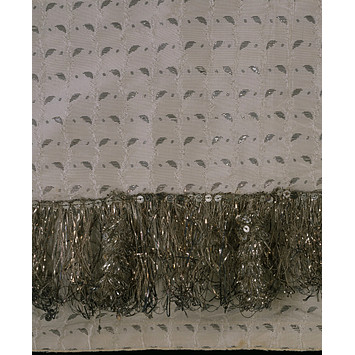
Detail of white and silver wedding dress petticoat worn by Miss Sarah Boddicott, 28 September 1779, V&A
Historical records though, do back up the frequency of gowns of white and silver. Metallic fabric were also very common among the nobility, as nothing says wealth more than cloth woven with gold or silver. Victoria’s tragic cousin Charlotte (who would have been queen had she not died in childbirth, and who was also her aunt because she married Victoria’s mother’s brother ) was married in a metallic cloth, as were most brides in the English royal family for centuries before her.
So, if royal brides in England and other European countries wore cloth of gold and silver, why did Victoria break with tradition and wear a white dress?
Well, because Victoria was not an ordinary bride. Unlike most royal brides, she did not enter the marriage as a princess, about to become the Queen Consort. She was the Queen, the head of state. She needed to make a statement as the leader of her country, not as an ornament to the throne and the future mother to the heir to the throne. So Victoria chose a dress that made a political statement. A dress that put her duty to her kingdom on display, rather than her wealth or beauty.
One of the main concerns in late 1830s England was the effect the Industrial Revolution was having on traditional textile industries. In particular, the invention of machine laces was decimating handmade lace industries across England, and causing widespread poverty and unemployment among the skilled artisans.
In order to stimulate and support the lace industry, Victoria chose for her wedding dress a large piece of handmade Honiton lace (read more about it here, on my now defunct textile blog). The rest of the dress then became a vehicle to showcase the lace, and white was chosen as the most suitable colour to do this. In the case of Victoria’s dress, white symbolised practicality and patriotism, rather than purity.
Alas for us, the skirt lace has since been removed from Victoria’s dress and recycled in other garments, and is now lost.
Victoria was so fond of her wedding attire, or so besotted with Albert and the whole romance of the wedding, that she posed for numerous paintings in her dress, and she and Prince Albert also dressed up in their wedding attire years later and recreated the wedding in photographs. A close inspection of all the different depictions of Victoria’s dress reveals numerous minor differences, making it very likely that she had elements of the dress altered as the mood suited her, and to align with changing fashions.
Victoria’s wedding attire was not devoid of symbolism though: she wore a wreath of orange blossoms (symbolising purity) and myrtle (symbolising love and domestic happiness), and these became the most common flowers carried and worn in Victorian weddings. A sprig of myrtle from Victoria’s bouquet was planted, and cuttings from the resulting bush have been carried by every royal bride in her family since then. Kate will almost certainly have one in her bouquet come the 29th.
Victoria’s wedding was widely publicised, and widely copied, sparking a huge increase in the number of brides who wore white (and the brides who wore lace, and the popularity of honiton lace, just as she had hoped). However, it wasn’t enough to make white the mode for every bride. In the 1840s white was still a very expensive fabric and colour, and only fairly wealthy women could afford a white dress. Some with just enough money did manage it, and then re-dyed the dress successively darker colours to hide marks and make it last for further seasons, meaning that there are less extant white wedding dresses than we might expect.
In addition, in 1840 the US was still struggling to establish its national identity, and women in the US were less inclined to take up fashions started by a British queen. This would change in the 1860s when the American Civil War encouraged women in both the South and the North to look to Britain as a cultural and fashion leader.

An engraving of the wedding of Victoria and Albert allowed wide distribution of images of her wedding dress
It was not until the 1850s and 1860s that the trends that Queen Victoria had initiated became widespread for brides. The high profile marriages of other British royal brides, such as Victoria’s daughter, Victoria the Princess Royal, and her daughter in law, Alexandra of Denmark, who both followed the traditions set by Victoria, helped to further conventionalise white wedding dresses. Other international royal brides, especially ones such as the Empress Eugenie, who were marrying into less stable monarchies, also followed Victoria’s lead to lend substance and respectability to their marriages.
The biggest factor, however, in popularising the white dress, was changing socio-economic circumstances. The 19th century saw the rise of a large middle class with expendable income for the first time in modern history. This middle class strove to emulate the customs of the upper class, and had the means to do so. And what family more epitomises the enviable aristocracy than the British royal family? Between Queen Victoria in 1840, Empress Eugenie in 1853, Princess Victoria in 1857, and Alexandra in 1863 the die was cast. White was the thing for brides to wear. If they could afford it.
Despite the rising middle class, many still couldn’t afford a dress only for their wedding day, and so ‘best’ dresses of any colour were worn by brides until the advent of very cheap and effective bleaches made white dresses for any occasion very common at the turn of the century.
Only in the 20th century would would all the meanings that we associate with white wedding dresses (virginity, for example), be retrospectively, and mostly incorrectly, applied to Victorian brides.
For an interesting visual tour of royal brides from the 19th century to today (and to see how many of them wore white!), check out this album.
And finally, for something both related and random, check out Victoria’s darling wedding shoes:
And a close up of the message inside:
Want!

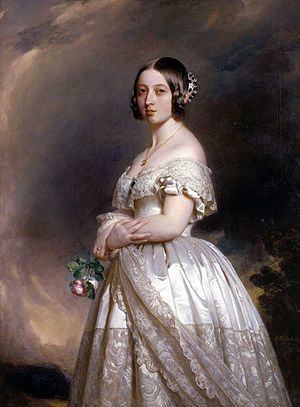
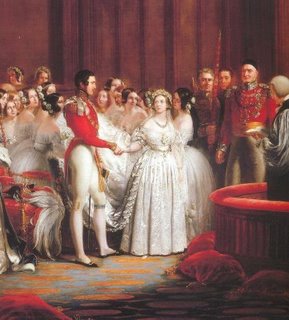

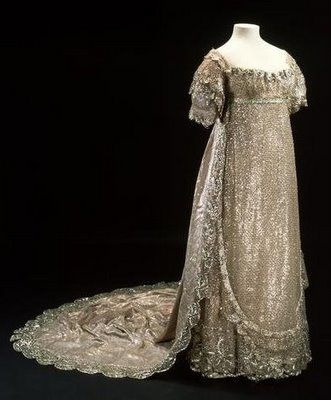
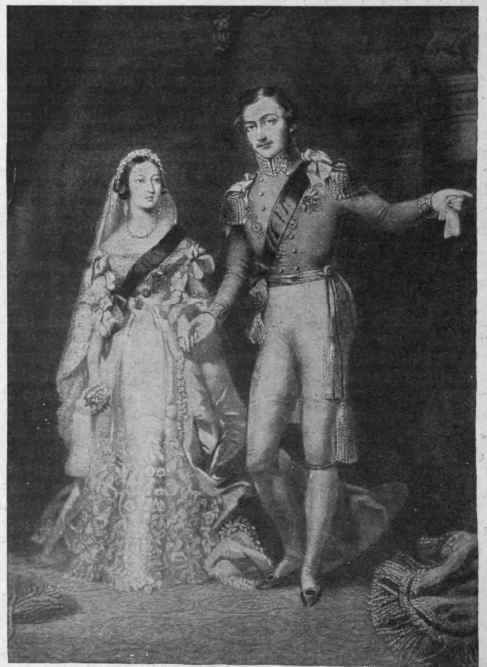
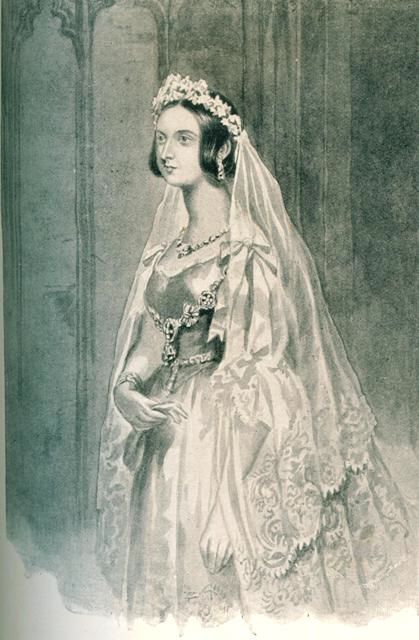
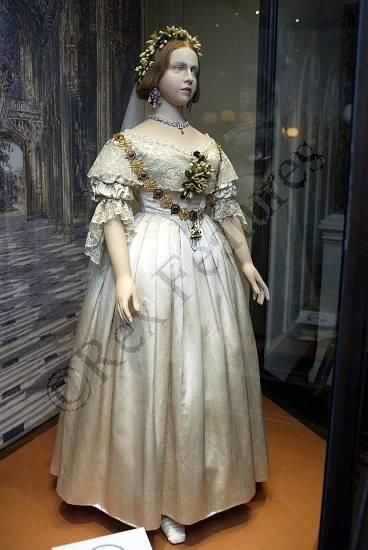

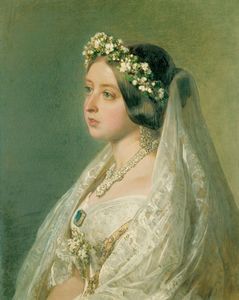
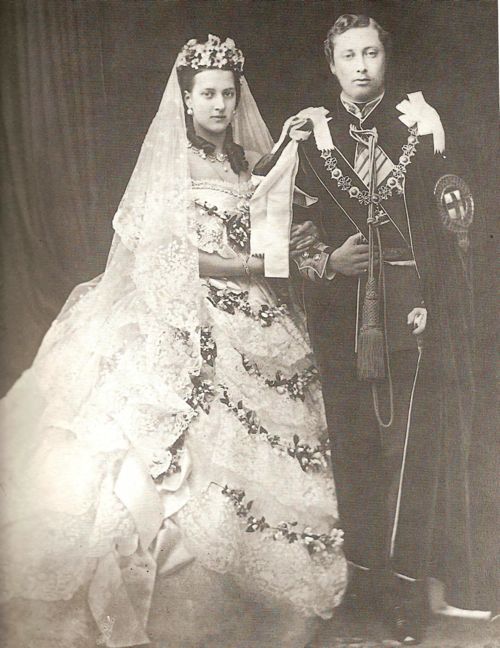

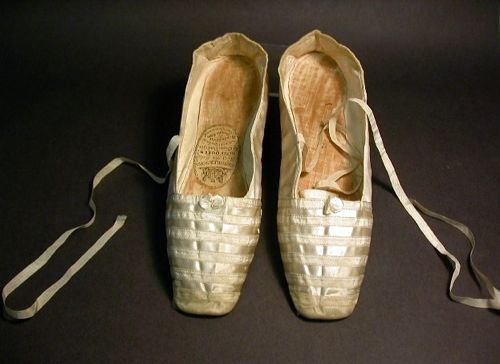
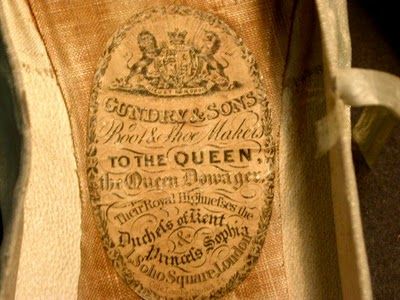
I got married in black, copper and gold and I made the dress myself. Now Im going to up-cycle it into a lovely empire dress.
Personally, I never liked the idea of an expensive, one time dress hoarded in the back of my closet. Most people just donate them to a thrift store and by then the style is considered old. Prom dresses suffer the same fate. I feel that it should be re-used or up-cycled and Im glad to see even Queen Victoria was not wasteful when it came to fashion.
Wow, thank you for an interesting and informative post. Great read, and so much I didn’t know- Honiton lace industry, the color white showing wealth rather than purity… I had to smile at the lovely photo of V and A staging their wedding day in middle age. It’s sweet isn’t it?
I’m thinking of altering and dyeing my wedding dress, like a middle class Victorian.. hehe.
Love it! I do hope you post about it if you do!
This is a great article, many thanks. I’ve just put a link to it in an article I’ve written on wedding dresses on my blog, Cut And Baste.
This is amazing information! I learned more on this site than I did at the V&A where I actually saw Victoria’s dress. What woman, of any era, would not want those exquisite shoes?
Awwww…thanks! I’m very glad you enjoyed this post, and very envious that you have seen the dress in real life. And yes, who wouldn’t want those shoes!
I recently found a tiny piece of white silk ribbon (about 10cm long) at an antique fair – it has Victoria and Albert’s name woven inside little garlands of flowers with a crown at the top of each garland.
The piece of ribbon has been stitched loosely onto another piece of fabric (to keep it from falling apart maybe) and has obviously been kept safe in the box I bought it in for many years. On the inside of the box is a note which says ‘Queen Victoria’s Wedding 1840. Do you have any idea whether this might have been from her dress – or maybe from something at the wedding reception?
Hi Shani,
What a fascinating find! Lucky you!
I suspect the ribbon is not actually something from the wedding or the reception, but was a souvenir that was sold to the populace to commemorate the wedding, or an anniversary. Just think of all the commemorative souvenirs that were sold for Wills and Kate. I don’t know if I have seen examples of souvenirs for V&A’s wedding, but I know of similar things that were sold for the Princess Royal’s wedding, and for Charlotte’s wedding before Victoria’s. It might have been meant to be a bookmark. Even if it didn’t actually belong to Victoria or a guest, it’s still a fabulous thing to have, and there probably aren’t that many still extant.
What a great article. I came upon your blog while researching something else wedding related and stayed to read this piece…glad I did. Discovered things I didn’t know about wedding gowns. Thanks
This is sooo cool. Just what I was researching. Not to be mean to the Queen, but she was UGLY!
Your comment is an interesting example of how tastes and standards of beauty change over time. Queen Victoria was considered very pretty in her youth – her sweet, girlish, round face was very fashionably, and set the standard for early Victorian beauty. After she was married she had 9 children in quick succession, which will take quite a toll on your body. That, combined with the stress of her position, and grief from loosing Albert, probably caused her to age quite quickly.
What a delightful read and amazing find this was!
Hello, thanks for such an interesting post!
Though, I’m quite confused about something you posted.
Can you just please explain this part again –
“Well, because Victoria was not an ordinary bride. Unlike most royal brides, she did not enter the marriage as a princess, about to become the Queen Consort. She was the Queen, the head of state. She needed to make a statement as the leader of her country, not as an ornament to the throne and the future mother to the heir to the throne. So Victoria chose a dress that made a political statement. A dress that put her duty to her kingdom on display, rather than her wealth or beauty.”
So, her dress was white and it represented wealth, but her dress did not represent wealth?
Sorry about the confusion, but I hope you can help me out.
Many thanks,
Constance.
Perhaps I can clarify a little.
White was an expensive colour to buy and maintain by the ordinary standard of bride, but royal brides are (understandably) quite out of the ordinary. So they wore gowns of cloth of gold or silver – considerably more expensive and more of a display of wealth than a white dress. Other extremely wealthy brides also wore gold or silver dresses, but they really did have to be extraordinarily wealthy. The point of Queen Victoria’s dress was that it wasn’t the gold or silver gowns worn by royal consorts (thus setting her apart from them), and its main decorative element was the lace that went over it (thus making a point that her dress supported a British industry).
Magnificent article, both the information and the pictures. Loved it. Thank you!
It was not merely Queen Victoria and her daughters who sealed the deal – Empress Elizabeth of Austria, who married in 1854, also chose white and she was very popular at the time. Same goes for the Dutch Queen Sophie or Sophia (then Princess) who wore white when she married in June 1839 (before Victoria had even proposed to Albert).
White showed wealth because a white dress was a rather useless object around the house. Have you tried to do some vigorous cleaning and cooking in a white dress? Dresses were re-used and a wedding dress was no exception. The story is that Jane Austen’s mother wore her red dress out, and then it was remade into a riding coat for her brother.
Victoria certainly re-used the lace on her dress: lace was expensive and even a queen would not discard it after wearing it only once. Except the veil: Victoria was buried in her wedding veil in 1901. Queen Sophie was buried in her wedding dress in 1877, although not for the sentimental reasons of Victoria, but because, in her own words ‘her life was over from the day of her marriage’.
What a wealth of information. Having just seen the TV special for the third time, all of the above makes everything seems so real and up to date. Thank you so much for making this available.
Hi
My name is Stella and in 1970 when we moved into our home in Montreal we found an engraving exactly like the one you have here . My question is would anyone know how much is worth ? should i have it insured ? are there many of them in existence ? any info would be welcomed
thanks in advance 🙂
Hi Stella,
I’m really not an expert on engravings, but I suspect that there were thousands of this one made, and many are still in existence, so the value is probably not very much – even if it is an original 19th century engraving (replicas have been made almost continuously since then). If you want an actual value you’d need to go to an appraiser – a local antiques dealer or auction house would be a good place to start. Note that they may charge a fee. Sometimes museums do ‘Antiques Roadshow style events where they will tell you about your items too.
Well if its ‘exactly’ like it , its probably worth a lot considering this engraving was an important part of queen Victoria’s history so , just me guessing it’d probably be in the millions.
Except engravings were done in the thousands, and possibly in the millions, particularly for scenes like this. So mid-19th century engravings are rarely worth much at all. I’d recommend taking it to a local antiques dealer to have it appraised.
[…] Queen Victoria’s Dress […]
[WORDPRESS HASHCASH] The comment’s server IP (92.48.90.86) doesn’t match the comment’s URL host IP (213.175.220.180) and so is spam.
[…] Blog, The. “Queen Victoria’s wedding dress: the one that started it all.” April 18, 2011. https://thedreamstress.com/2011/04/queen-victorias-wedding-dress-the-one-that-started-it-all/. 4. “Elegance of a Victorian Wedding, Part I, The.” Hudson Valley Weddings, accessed January […]
[WORDPRESS HASHCASH] The comment’s server IP (69.160.49.65) doesn’t match the comment’s URL host IP (69.160.49.66) and so is spam.
When I was on my teens, I wish to be back on their time and be one of the daughter of this royalties where the wear gown almost everyday and dress like princess.
[…] For the whole story behind Queen Victoria’s dress, read the excellent blog post at Dreamstress. […]
I was researching the history of Honiton lace when I came across your site. What a great story! If all history was taught this way, I’m sure our students would remember more of it. It helps to hear about the people, the place, the economy and other interesting details to make it come alive. You have done a great job! Thanks.
I am the great great great granddaughter of Richard Gundry whose firm made Queen Victoria’s wedding shoes as pictured in your article. My line comes from one of Richard’s sons, Jonathan, who was still in business with his father in 1842, then Jonathan’s oldest son, Richard Gundry, father of Lewis Henry Gundry, who is father of Lewis Perkins Gundry, my father. I knew that Richard Gundry and Sons made shoes at 1 Soho Square, London, and followed the location for several years in the post books which said “shoemaker to the Queen”, but this is the first time I have actually seen a picture of the shoes. Lois Mackin, a professional genealogist and a friend of mine, sent me this link. Thank you all who had something to do with it. Parker Gundry Trostel, living in Minneapolis, MN
[…] Doing some research I found from thedreamstress.com that women often wore white not to demonstrate purity, as so many believe, but rather to demonstrate wealth. (To read the full article click here) […]
Gorgeous Wedding dress. Nobody makes wedding dresses like that anymore. It reminds me of my Great Grandma’s wedding dress, it was a beautiful dress. It is treasured by our family for centuries. Those are some really rare beautiful pictures. Thanks for sharing this post with us.
smithsonianmag.comsmithsonianmag.comYour Friend, Loran Watkins, posted this article’s link onto the Smithsonian Article, Queen Victoria Dreamed Up the White Wedding Dress. Your article is so much more informative, Thank you. I provide the link below to the Smithsonian Article.
http://www.smithsonianmag.com/smart-news/queen-victoria-sparked-white-wedding-dress-trend-1840-180953550/?utm_source=smithsoniantopic&utm_medium=email&utm_campaign=20141214-Weekender&spMailingID=21840604&spUserID=NzQwNDU4MjE1NDES1&spJobID=461380440&spReportId=NDYxMzgwNDQwS0
Nice history, I now know about the Origin of wedding gowns but most Africans have also adopted this tradition of the British and yet many do not know it’s origin and am glad to know. Am from Ghana, West Africa
I love a wedding, even if I’m only going as a guest. I love the whole whirlwind romance of love, dressing up, of it being your one day to be the star and all of the attention. Not that I wore white to either of my weddings. But I’m a great believer in one dress (white if at all possible) for the day and if you look amazing in a white dress, wear it. I don’t care if there is an expense in regards to the dress. You are the main ‘actress in your play’, so why not go all out and do the job right. Only if you can afford to that is. I had my second wedding dress made in an amazing blood red slab silk with a tight fitted bodice and a de-attachable train but I’m not keen on my daughter wearing it. For me, white wasn’t a colour I felt comfortable in. My first dress was a soft blush apricot. I have my dress stored away just for me to admire every so often and I hope when the day comes, my daughter will venture out and design her own dress with as much enthusiasm and guts as myself and be different. Spend the money, it’s only one day and it’s yours. Then lovingly store it away in your closet, I did and I would do it all over again but hubby has said “no way!” Keep your dress, don’t alter it for a cocktail dress or give it to a second-hand shop. Treasure it!
Having just read a book called the royal pacemaker was about queen Victoria’s wedding dress so the author must have done some history enquiries if that is the case it was held a very. Big secret